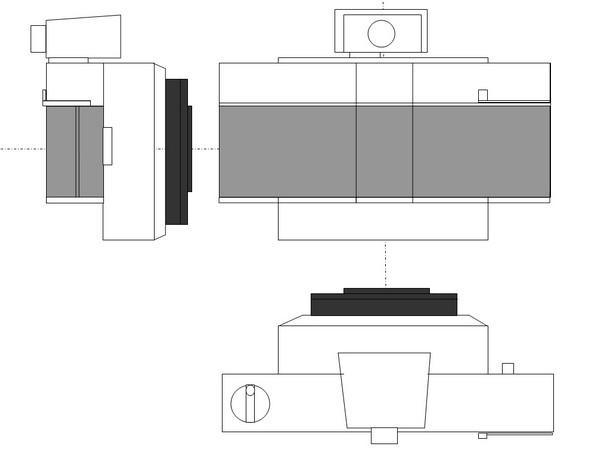35mm Panoramic Camera (2010)
So as portable as the camera may be, it is of limited use handheld, because enough light for 1/125 and f=22 is rare on this side of the world.
Added to that, I meanwhile find the aspect ratio somewhat "in between". While no longer a standard ratio, it is rather unspectacular for a panoramic camera. So my thoughts started wandering again...
The widest format I have found is 6x24, i.e. an aspect ration of 4.3:1. This IS spectacular, but these cameras again tend to be very heavy and big.
But if I was going to do it then I should DO it, so 4.3:1 was the goal, however, this was the idea, on 35mm film, to make the camera smaller and less pricey.
First, I had to find a wide angle lens with shutter, with an image circle of more than 105mm (that would not cost a fortune). I ended up looking for Mamiya Press lenses. While only single coated, those lenses have a good reputation (and a big enough image circle).
The Press lenses usually sit in front of 6x9 cameras, but since some of those cameras have movable backs, the lenses are obviously designed with a generous image circle, to allow for some tilt/shift movement.
This was the plan:

I
eventually used a Mamiya Press standard body from about 1965:

And
this is what was left after the hacksaw attack:

The rear part of the camera consists of three bodies taken from Dacora Dignette 35mm cameras, from the late sixties. Those cameras are well suited because of their simple construction and their aluminium body, that is easy to work with.
Here are the three rear parts, glued together:

Front and rear part need to be correctly positioned relative to each other, for which I used a piece of ground glass in the film plane and a 150mm lens:



Pictures
showing the further assembly steps


And
this is the finished camera:


Or,
meanwhile painted in "professional black" with the beautiful 6.3/50,
equaling a 17mm lens on 35mm

One film transport needs three strokes, and this adds up to 11 pictures on a standard (36 exp.) roll of 35mm film, or 12, if the film is put into the camera in the dark.
The negatives look good (slides look even better...), at least if the lab manages to cut the film in between of the images...
I hate to say it, but I still have some light leaks to find (very strange indeed. I believe I have already looked everywhere).
The camera is a littry tricky to use, it has to be held very straight, even small inclinations lead to very crooked images.
The possible resolution is on the level of e.g. a Canon 5D Mark II, so expect no miracles - but lots of fun.
Three
sample pictures (nothing artistic...):


This is Delft, The Netherlands, after Vermeer:

